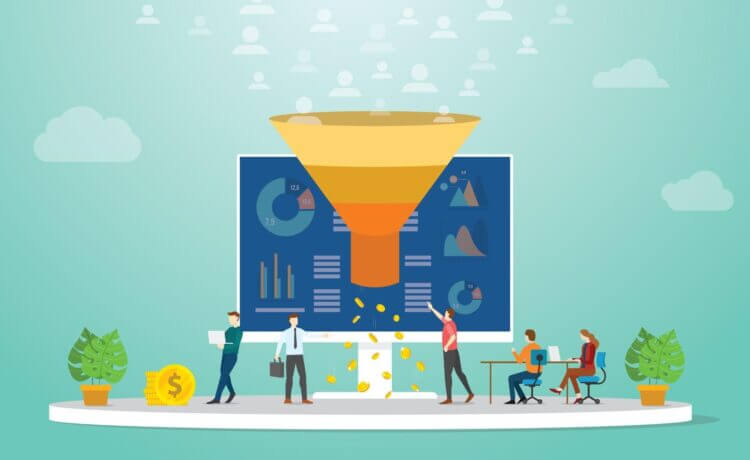The more opportunities in your sales pipeline, the more likely you are to achieve your revenue goals. Managing a successful sales pipeline is possible through careful assessment. But what exactly is the sales pipeline? Why is it so important to successful sales?
A sales pipeline is a term that has been bandied around, and everyone is expected to know what it means. But if you don’t, this guide will tell you everything you need to know.
What is a sales pipeline?
A sales pipeline is a step-by-step visual representation of a lead’s different stages before becoming a buyer or customer. It is a simple tool that helps businesses get organized, maximize their profits and prevent any leads from falling through the gaps. Since salespersons juggle various deals simultaneously, they need to create a sales pipeline. You can use templates for creating a quick sales pipeline example so that your sales team can get an overview of all their leads. It’ll help them take concrete actions to close deals and bring value to your business.
Each sales pipeline is unique because sales processes differ from business to business. However, regardless of your business niche, a sales pipeline will:
- Offer accurate business forecasts and enhance your sales process.
- Provide automatic and accurate sales reporting, along with insights into the success of various sales strategies
- Enable you to allocate resources efficiently where required and provide a more personalized, accurate outreach
- Help your sales team get on top of all the deals, align outreach and message between different teams, and prevent leads from through the gaps.
Difference between a sales pipeline and sales funnel
Often, sales funnel, and sales pipeline are used interchangeably. However, they’re not the same. A sales pipeline represents the stages a prospect goes through to become a customer. On the other hand, a sales funnel represents the number of prospective customers who make it through those stages.
A sales pipeline looks at the various sales process steps, from gaining a lead to closing the sale. It is brand-oriented as it looks internally at all the stages that your marketing and sales teams need to move a prospective customer through to make them a customer and retain them. While a sales funnel looks at the entire customer journey, from becoming aware of the brand to make a purchase.
The sales funnel focuses on the customer and looks at all the stages a customer has to go through to purchase.
Difference between sales pipeline and sale forecast
Sales forecasts and sales pipelines are often confused by people. A sales pipeline includes all the opportunities a salesperson is handling, including newly identified opportunities and those that are ready to close. On the other hand, a sales forecast estimates the opportunities that are likely to close within a specific period. It shows sales managers and salespeople how closely they are trending toward their objectives and helps them prepare for what will come.
If the sales forecast anticipates that you will miss your quota, you need to double down on selling activities. If the forecast shows you are on track to make 150% of your quota, you would want to scale back your efforts and lay the groundwork for the next month.
Stages of sales pipeline
Prospecting
The first stage in a sales pipeline is prospecting, and it means identifying the people who might have an interest in your offerings. Then, you have to work to ensure your products are visible to them.
When it comes to prospecting, there are different approaches like:
- Cold prospecting: Cold prospecting is when your team reaches out to prospective clients through different avenues, such as social selling and cold calling. The goal is to reach out to people who haven’t yet engaged with your enterprise and make them a part of your sales pipeline.
- Warm prospecting: Warm prospecting is focused on making a connection with prospects who have shown interest in your offerings. They have signaled an interest in your service or product and agreed to share their personal information.
Qualifying
Once you’ve identified the prospect, the next step is to determine their level of interest to move them through the pipeline. If they’re serious, they will be upgraded to a lead.
Consideration
After you have determined a lead fits your criteria, it is time to continue personalized and targeted outreach to them through marketing automation, content distribution, and other channels.
During this stage, your leads will review your products or services to ensure they fit their budget and business needs. At the same time, they might also review similar products from your competitors.
When your leads are in the consideration stage, it would be best to provide targeted information to help make informed decisions.
Purchase or decision
The purchase step may seem like an easy one to negotiate, but it is not. Since your prospects have stayed loyal to you throughout the preceding steps, you may think it’ll be easy to get them to purchase your product or sign a document. Unfortunately, you cannot breathe a sigh of relief just yet.
At this stage, your prospect needs to make a decision. Whatever the decision, ensure to keep calm. Even if the decision doesn’t go your way, you must not show your frustration. It is all about maintaining long-lasting relationships so that you can come back to the prospect when your company launches a new product or service.
Delivery
You’ll probably get an approved deal if you have moved along your prospect through all the steps mentioned above. But your task isn’t finished after you’ve delivered the product or service to your new client.
In the delivery stage, it is crucial to make good on any promises you might have made. You can create a seamless transition for the client, moving them from the sales team to working with your customer service professionals. After that, your customer support team works with them to ensure their needs are looked after, and grievances are addressed.
To sum up, a sales pipeline is at the core of achieving sales success. Improve the efforts made by your sales team by refining and creating a sales pipeline that fits your organization.




